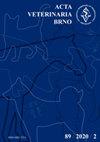被动初乳转移对犊牛溶血性曼海默病选定抗原体液免疫的影响
IF 0.7
4区 农林科学
Q3 VETERINARY SCIENCES
引用次数: 0
摘要
本研究的目的是评估牛呼吸道疾病复合体(BRDC)病原免疫的有效性,评估抗溶血性曼海氏病(Mannheimia haemtica)初抗体对免疫的抑制作用,并分析犊牛急性期蛋白。用溶血支原体白毒素(Lkt)和外膜蛋白(OMPs)分别在分娩前6周和4周免疫荷斯坦-弗里沙和西门塔尔奶牛和犊牛。犊牛产犊后直接采集血清和初乳。分别在犊牛初乳摄入前和出生后48 h采集血清。将接种疫苗和未接种疫苗的犊牛放在饲养场,分别在第10天和第24天接种Lkt或OMP。对小牛进行了呼吸道病毒血清抗体检测。从所有死于BRDC的小牛身上采集气管和肺部样本进行细菌学检查。结果表明,48 h犊牛初乳值和IgG转移量较高(> 12.5 g/l), 48 h犊牛抗bvd抗体浓度较高(> 33-45 mg/ml)。在牛疱疹病毒BHV-1和牛呼吸道sycytil病毒BRSV中观察到相似的值。副流感PI-3和腺病毒特异性抗体的免疫球蛋白浓度最高。各实验组犊牛对溶血支原体抗原的抗体水平均最低(接种溶血支原体抗原的犊牛抗体水平< 50 mg/ml,未接种溶血支原体抗原的犊牛抗体水平< 25 mg/ml)。研究结果表明,需要对犊牛进行早期免疫接种,这通常是由于与运输和适应饲养场新条件相关的压力而无法实现的。本文章由计算机程序翻译,如有差异,请以英文原文为准。
The influence of passive colostrum transfer on humoral immunity to selected antigens of Mannheimia haemolytica in calves
The aim of the study was to evaluate the effectiveness of colostral immunity against aetiological agents of bovine respiratory disease complex (BRDC), to assess the suppressive effect of colostral antibodies against Mannheimia haemolytica on immunity, and to analyse acute phase proteins in calves. Holstein-Friesian and Simmental cows and calves were immunized with M. haemolytica leukotoxin (Lkt) and outer membrane proteins (OMPs) at 6 and 4 weeks before parturition. Sera and colostrum were collected from the cows directly after calving. Sera from calves were obtained before colostrum intake and 48 h after birth. Calves from vaccinated and unvaccinated cows were placed in the feedlot and immunized with Lkt or OMP on days 10 and 24. Calves were tested for serum antibodies against respiratory viruses. Trachea and lung samples were collected for bacteriological examination from all calves that had died with BRDC. The results indicated high colostrum values and IgG transfer in calves at 48 h (> 12.5 g/l) and a high concentration of anti-BVD antibodies in calves at 48 h (> 33–45 mg/ml). Similar values were observed for bovine herpes virus BHV-1 and bovine respiratory sycytil virus BRSV. Immunoglobulin concentrations were highest for antibodies specific to parainfluenza PI-3 and adenoviruses. The lowest antibody levels were detected against M. haemolytica antigens in all experimental groups of calves (< 50 mg/ml in calves of cows vaccinated with M. haemolytica antigens and < 25 mg/ml in calves of unvaccinated cows). The findings indicate the need for early immunization of calves, which is often precluded by stress associated with transport and adaptation to the new conditions in the feedlot.
求助全文
通过发布文献求助,成功后即可免费获取论文全文。
去求助
来源期刊

Acta Veterinaria Brno
农林科学-兽医学
CiteScore
1.00
自引率
33.30%
发文量
36
审稿时长
18-36 weeks
期刊介绍:
ACTA VETERINARIA BRNO is a scientific journal of the University of Veterinary and Pharmaceutical Sciences in Brno, Czech Republic.
The scientific journal Acta Veterinaria Brno is dedicated to the publication of original research findings and clinical observations in veterinary and biomedical sciences. Original scientific research articles reporting new and substantial contribution to veterinary science and original methods that have not been submitted for publication elsewhere are considered for publication. A written statement to this effect should accompany the manuscript, along with approval for publication by the author´s head of department. The authors bear full responsibility for the contents of their contribution. Book reviews are published, too.
 求助内容:
求助内容: 应助结果提醒方式:
应助结果提醒方式:


